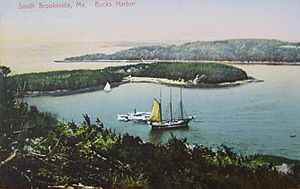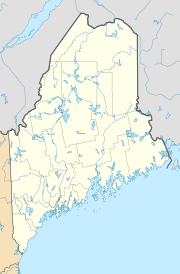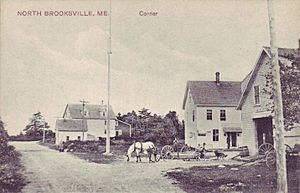Brooksville, Maine facts for kids
Quick facts for kids
Brooksville, Maine
|
|
|---|---|

View of Buck's Harbor c. 1910
|
|
| Country | United States |
| State | Maine |
| County | Hancock |
| Incorporated | 1817 |
| Villages | Brooksville Harborside Herricks North Brooksville Norumbega South Brooksville West Brooksville |
| Area | |
| • Total | 51.12 sq mi (132.40 km2) |
| • Land | 31.13 sq mi (80.63 km2) |
| • Water | 19.99 sq mi (51.77 km2) |
| Elevation | 131 ft (40 m) |
| Population
(2020)
|
|
| • Total | 935 |
| • Density | 30/sq mi (11.6/km2) |
| Time zone | UTC-5 (Eastern (EST)) |
| • Summer (DST) | UTC-4 (EDT) |
| ZIP Codes |
04617 (Brooksville)
04642 (Harborside) |
| Area code(s) | 207 |
| FIPS code | 23-07975 |
| GNIS feature ID | 0582372 |
Brooksville is a small town located on Penobscot Bay in Hancock County, Maine, United States. In 2020, about 935 people lived there. The town includes several small villages like North Brooksville, South Brooksville, West Brooksville, Brooksville Corner, and Harborside.
Contents
History of Brooksville
People have likely lived in the Brooksville area for over 11,000 years. Before European settlers arrived, Native American groups, part of the Wabanaki confederation, lived here. The people in the Brooksville area were probably Penobscot.
There's a story that English settlers attacked a Wabanaki village at Walker Pond between 1690 and 1704. It's hard to know if this story is true. In 1912, archaeologists found a Native American grave near Walker Pond, but they couldn't tell how old it was.
Brooksville's first English settlers were John Wasson, Samuel Wasson, and David Hawes. They were soldiers in the Revolutionary War. The town officially became a town on June 13, 1817. It was created from parts of nearby towns like Castine, Penobscot, and Sedgwick. The town was named after Governor John Brooks of Massachusetts, who was in charge of Maine at that time.
The land in Brooksville has a lot of granite. Several quarries, which are places where stone is dug up, were started. The soil is good for farming, and people grew wheat and potatoes.
Buck's Harbor is a safe and deep cove, great for small boats. Many people in Brooksville worked in shipping and fishing. By 1880, when the town had 1,419 people, Brooksville had factories that made fish oil, and mills that cut wood, ground grain, and processed wool.
Shipping was a big business. Ships were repaired at Wasson's Wharf Road. There was also a brickyard, a blacksmith's shop, and a rope factory. In 1912, 18 large sailing ships called schooners were being repaired at the wharf. A small boat called the Goldenrod took passengers from Brooksville to Castine. Many members of the Wasson and Tapley families became ship captains.
Brooksville's Cape Rosier is named after James Rosier. He was an early explorer of the Penobscot River.
-
Steamboat leaving in 1909
Geography of Brooksville
Brooksville covers about 51 square miles (132 square kilometers). About 31 square miles (81 square kilometers) is land, and 20 square miles (52 square kilometers) is water.
Brooksville is surrounded by water on three sides. To the west is Penobscot Bay. To the north and east is the Bagaduce River, which is a tidal estuary (where fresh river water mixes with salty ocean water). To the south is Eggemoggin Reach. The town is almost an island, connected to the mainland by only two narrow strips of land. It has about 53.75 miles (86.5 kilometers) of shoreline.
State roads 175 and 176 pass through Brooksville.
Population Information
The population of Brooksville has changed over the years. In 1820, there were 972 people. The population grew to 1,419 in 1880. By 2020, the population was 935 people.
In 2010, there were 934 people living in Brooksville. The average age of people in the town was 53 years old. About 15% of residents were under 18, and about 25% were 65 or older.
Fun Places to Visit
Brooksville has many interesting places to see:
- Bagaduce Lunch: A famous clam shack that has won awards for its delicious seafood.
- Brooksville Historical Society Museum: Learn about the town's past.
- Callahan mine: This is a former mine that is now a Superfund site. This means it's a place where the environment needed cleaning up.
- Four Season Farm: This is a nationally known organic farm run by Eliot Coleman and Barbara Damrosch. They grow food without using harmful chemicals.
- Good Life Center: This was the home of Helen and Scott Nearing. They believed in simple living, which means living a life that is not complicated and focuses on what's important. The center helps share their ideas.
- Holbrook Island Sanctuary State Park: A protected natural area on Penobscot Bay. It's a great place for hiking and watching wildlife.
- The reversing falls on the Bagaduce River at Davis Narrows: Here, the water flows in one direction, then reverses and flows the other way, depending on the tides. You can see this where Routes 175 and 176 cross the river.
- The reversing falls at Goose Pond in Harborside: Another spot where you can see the water change direction with the tides.
Important Historic Sites
Several places in Brooksville are listed on the National Register of Historic Places. This means they are important for their history or architecture.
- Topside: Added to the list in 1975.
- Von Mach Site: Added to the list in 1989.
- West Brooksville Congregational Church: Added to the list in 1995.
Famous People from Brooksville
Many notable people have connections to Brooksville:
- Eliot Coleman: A farmer, author, and teacher who supports organic farming.
- Melissa Coleman: An author and writer.
- Clarence Milville Condon: Received the Medal of Honor for bravery during the Philippine–American War.
- Archibald Cox: A law professor and lawyer who worked for the U.S. government. He was involved in the Watergate scandal, a big political event in the 1970s.
- Daniel Hoffman: A famous poet who was the poet laureate of the United States from 1973 to 1974.
- Edmund von Mach: A German-American expert on art history.
- John Mack: A seaman in the Civil War who received the Medal of Honor.
- Robert McCloskey: An award-winning author and illustrator of children's books.
- Helen Nearing: With her husband Scott, she was a leader in the back-to-the-land movement. They encouraged people to live simply and grow their own food.
- Scott Nearing: Helen Nearing's husband, also a strong supporter of simple living.
- Clara Parkes: An author and expert on yarn and wool.
- Robert Shetterly: A painter known for his portraits of "Americans Who Tell The Truth."
- Peter Suber: A leader in the open access movement, which aims to make research freely available to everyone.
- Lucy Hale Tapley: An American educator and president of Spelman College.
- David Atwood Wasson: An important American thinker in early American history.
See also
 In Spanish: Brooksville (Maine) para niños
In Spanish: Brooksville (Maine) para niños








